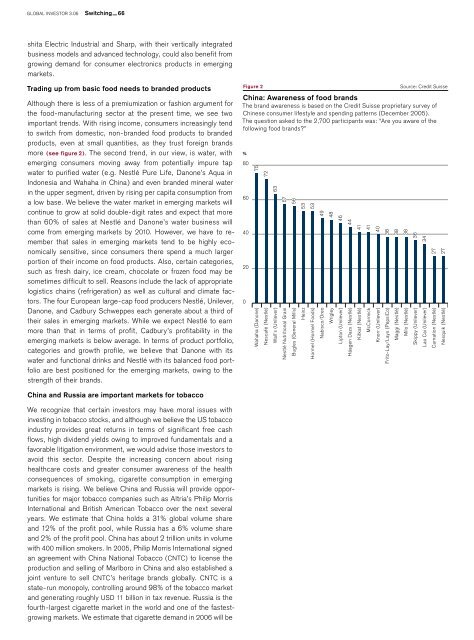Banking for 7 billion and 7 million
New challenges and opportunities of globalization Global Investor, 03/2006 Credit Suisse
New challenges and opportunities of globalization
Global Investor, 03/2006
Credit Suisse
You also want an ePaper? Increase the reach of your titles
YUMPU automatically turns print PDFs into web optimized ePapers that Google loves.
GLOBAL INVESTOR 3.06 Switching — 66<br />
shita Electric Industrial <strong>and</strong> Sharp, with their vertically integrated<br />
business models <strong>and</strong> advanced technology, could also benefit from<br />
growing dem<strong>and</strong> <strong>for</strong> consumer electronics products in emerging<br />
markets.<br />
Trading up from basic food needs to br<strong>and</strong>ed products<br />
Although there is less of a premiumization or fashion argument <strong>for</strong><br />
the food-manufacturing sector at the present time, we see two<br />
important trends. With rising income, consumers increasingly tend<br />
to switch from domestic, non-br<strong>and</strong>ed food products to br<strong>and</strong>ed<br />
products, even at small quantities, as they trust <strong>for</strong>eign br<strong>and</strong>s<br />
more (see figure 2). The second trend, in our view, is water, with<br />
emerging consumers moving away from potentially impure tap<br />
water to purified water (e.g. Nestlé Pure Life, Danone’s Aqua in<br />
Indonesia <strong>and</strong> Wahaha in China) <strong>and</strong> even br<strong>and</strong>ed mineral water<br />
in the upper segment, driven by rising per capita consumption from<br />
a low base. We believe the water market in emerging markets will<br />
continue to grow at solid double-digit rates <strong>and</strong> expect that more<br />
than 60% of sales at Nestlé <strong>and</strong> Danone’s water business will<br />
come from emerging markets by 2010. However, we have to remember<br />
that sales in emerging markets tend to be highly economically<br />
sensitive, since consumers there spend a much larger<br />
portion of their income on food products. Also, certain categories,<br />
such as fresh dairy, ice cream, chocolate or frozen food may be<br />
sometimes difficult to sell. Reasons include the lack of appropriate<br />
logistics chains (refrigeration) as well as cultural <strong>and</strong> climate factors.<br />
The four European large-cap food producers Nestlé, Unilever,<br />
Danone, <strong>and</strong> Cadbury Schweppes each generate about a third of<br />
their sales in emerging markets. While we expect Nestlé to earn<br />
more than that in terms of profit, Cadbury’s profitability in the<br />
emerging markets is below average. In terms of product portfolio,<br />
categories <strong>and</strong> growth profile, we believe that Danone with its<br />
water <strong>and</strong> functional drinks <strong>and</strong> Nestlé with its balanced food portfolio<br />
are best positioned <strong>for</strong> the emerging markets, owing to the<br />
strength of their br<strong>and</strong>s.<br />
Figure 2<br />
Source: Credit Suisse<br />
China: Awareness of food br<strong>and</strong>s<br />
The br<strong>and</strong> awareness is based on the Credit Suisse proprietary survey of<br />
Chinese consumer lifestyle <strong>and</strong> spending patterns (December 2005).<br />
The question asked to the 2,700 participants was: “Are you aware of the<br />
following food br<strong>and</strong>s?”<br />
%<br />
80<br />
60<br />
40<br />
20<br />
0<br />
75<br />
Wahaha (Danone)<br />
72<br />
Nescafé (Nestlé)<br />
63<br />
Wall’s (Unilever)<br />
57<br />
Nestlé Nutritional Grain<br />
56<br />
Bugles (General Mills)<br />
53<br />
Heinz<br />
53<br />
Hormel (Hormel Foods)<br />
49<br />
Nabisco/Oreo<br />
48<br />
Wrigley<br />
46<br />
Lipton (Unilever)<br />
44<br />
Häagen Dazs (Nestlé)<br />
41<br />
Kitkat (Nestlé)<br />
41<br />
McCormick<br />
40<br />
Knorr (Unilever)<br />
38<br />
Frito-Lay/Lays (PepsiCo)<br />
38<br />
Maggi (Nestlé)<br />
38<br />
Milo (Nestlé)<br />
36<br />
Skippy (Unilever)<br />
34<br />
Lao Cai (Unilever)<br />
27<br />
Carnation (Nestlé)<br />
27<br />
Nesquik (Nestlé)<br />
China <strong>and</strong> Russia are important markets <strong>for</strong> tobacco<br />
We recognize that certain investors may have moral issues with<br />
investing in tobacco stocks, <strong>and</strong> although we believe the US tobacco<br />
industry provides great returns in terms of significant free cash<br />
flows, high dividend yields owing to improved fundamentals <strong>and</strong> a<br />
favorable litigation environment, we would advise those investors to<br />
avoid this sector. Despite the increasing concern about rising<br />
healthcare costs <strong>and</strong> greater consumer awareness of the health<br />
consequences of smoking, cigarette consumption in emerging<br />
markets is rising. We believe China <strong>and</strong> Russia will provide opportunities<br />
<strong>for</strong> major tobacco companies such as Altria’s Philip Morris<br />
International <strong>and</strong> British American Tobacco over the next several<br />
years. We estimate that China holds a 31% global volume share<br />
<strong>and</strong> 12% of the profit pool, while Russia has a 6% volume share<br />
<strong>and</strong> 2% of the profit pool. China has about 2 trillion units in volume<br />
with 400 <strong>million</strong> smokers. In 2005, Philip Morris International signed<br />
an agreement with China National Tobacco (CNTC) to license the<br />
production <strong>and</strong> selling of Marlboro in China <strong>and</strong> also established a<br />
joint venture to sell CNTC’s heritage br<strong>and</strong>s globally. CNTC is a<br />
state-run monopoly, controlling around 98% of the tobacco market<br />
<strong>and</strong> generating roughly USD 11 <strong>billion</strong> in tax revenue. Russia is the<br />
fourth-largest cigarette market in the world <strong>and</strong> one of the fastestgrowing<br />
markets. We estimate that cigarette dem<strong>and</strong> in 2006 will be

















